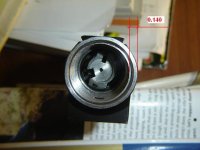G'day all
Just wanting get some advice from the more Knoledgable smiths here.
I was truing up one of my old sako actions this weekend, the usual set up in a spider chuck with a mandrel down the raceway to clock off.
Faced the front face and the lugs no problem, but made a huge stuffup skimming the threads..
I correctly set the gearbox to cut the required 16 TPI but i didn't check the change wheels which were set for metric thread.
I am normaly very thorough with this type of thing but i was in too much damn hurry.
Anyway the result was badly mangled threads..
After resetting the machine and re-cutting the threads to clean up , the receiver now looks pretty thin. Actualy it's 0.140 from the top of the threads to the outside of the receiver.. See attached pic. The front 2 threads have be machined out(the step you can see).
Is this too thin now to be used safely?? The rifle was to be chambered in .308 Win.
Thanks
Leeroy
Just wanting get some advice from the more Knoledgable smiths here.
I was truing up one of my old sako actions this weekend, the usual set up in a spider chuck with a mandrel down the raceway to clock off.
Faced the front face and the lugs no problem, but made a huge stuffup skimming the threads..
I correctly set the gearbox to cut the required 16 TPI but i didn't check the change wheels which were set for metric thread.
I am normaly very thorough with this type of thing but i was in too much damn hurry.
Anyway the result was badly mangled threads..
After resetting the machine and re-cutting the threads to clean up , the receiver now looks pretty thin. Actualy it's 0.140 from the top of the threads to the outside of the receiver.. See attached pic. The front 2 threads have be machined out(the step you can see).
Is this too thin now to be used safely?? The rifle was to be chambered in .308 Win.
Thanks
Leeroy


